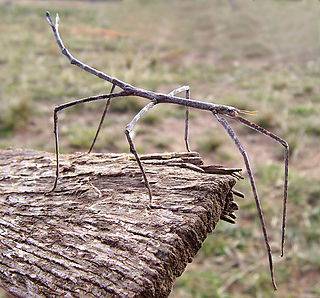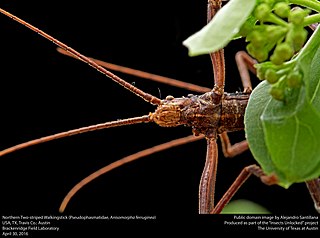
The Phasmatodea are an order of insects whose members are variously known as stick insects, stick-bugs, walkingsticks, stick animals, or bug sticks. They are also occasionally referred to as Devil's darning needles, although this name is shared by both dragonflies and crane flies. They can be generally referred to as phasmatodeans, phasmids, or ghost insects, with phasmids in the family Phylliidae called leaf insects, leaf-bugs, walking leaves, or bug leaves. The group's name is derived from the Ancient Greek φάσμα phasma, meaning an apparition or phantom, referring to their resemblance to vegetation while in fact being animals. Their natural camouflage makes them difficult for predators to detect; still, many species have one of several secondary lines of defense in the form of startle displays, spines or toxic secretions. Stick insects from the genera Phryganistria, Ctenomorpha, and Phobaeticus include the world's longest insects.

The family Phylliidae contains the extant true leaf insects or walking leaves, which include some of the most remarkably camouflaged leaf mimics (mimesis) in the entire animal kingdom. They occur from South Asia through Southeast Asia to Australia. Earlier sources treat Phylliidae as a much larger taxon, containing genera in what are presently considered to be several different families.

The Euphasmatodea, also known by its junior synonym Verophasmatodea is a suborder of the Phasmatodea, which contains the vast majority of the extant species of stick and leaf insects, excluding the Timematodea. The oldest record of Euphasmatodea is Araripephasma from the Crato Formation of Brazil, dating to the Aptian stage of the Early Cretaceous.

The Phasmatidae are a family of the stick insects. They belong to the superfamily Anareolatae of suborder Verophasmatodea.

Ctenomorpha marginipennis, the margin-winged stick insect, is a species of stick insect endemic to southern Australia. The species was first described by George Robert Gray in 1833.

Diapheromera arizonensis, the Arizona walkingstick, is a species of walkingstick in the family Diapheromeridae. It is found in North America.

Parabacillus hesperus, the western short-horn walkingstick, is a species of walkingstick in the family Heteronemiidae. It is found in North America. This species is found in dry, arid in the summer and fall. Their diet consists of various scrub and grassland plants. Through an adaptation called "crypsis," it blends in so perfectly with its natural habitat that it often goes completely undetected by would-be predators.

Anisomorpha ferruginea is a species in the family Pseudophasmatidae, in the order Phasmatodea ("walkingsticks"). Common names include "northern two-striped walkingstick", "dark walkingstick", and "prairie alligator". Anisomorpha ferruginea is found in North America. This insect can spray a defensive mist that contains a terpene dialdehyde.

Diapheromera is a genus of stick insects in the family Diapheromeridae. There are about 14 described species in Diapheromera.

Oligotomidae is a family of webspinners in the order Embioptera. There are about 6 genera and at least 40 described species in Oligotomidae.

Parabacillus is a genus of short-horn walkingsticks in the family Heteronemiidae. There are at least three described species in Parabacillus.
Canuleius is a genus of walkingsticks in the family Heteronemiidae. There are at least 20 described species in Canuleius.

Aschiphasmatidae are a family of stick insects belonging to the suborder Verophasmatodea; they can be found in Indomalaya.

Diapheromerini is a tribe of walkingsticks in the family Diapheromeridae. There are at least 30 genera Diapheromerini.

Anisacanthidae is a family of stick insects in the superfamily Bacilloidea. There are at least 30 described species in Anisacanthidae, all from Madagascar.
Damasippoididae is a family of walkingsticks in the order Phasmatodea. There are at least two genera and about six described species in Damasippoididae, found in Madagascar.

Phasmatini is a tribe of stick insects in the family Phasmatidae. There are more than 40 described species, found in Australasia, and Asia

The Obriminae are the most species-rich subfamily of the Phasmatodea family Heteropterygidae native to Southeast Asia. It is divided into two tribe.

Datamini is the only tribe within the subfamily of the Dataminae from the order of the Phasmatodea. The representatives of this subfamily are on average not as large as those of the other two subfamilies belonging to the family of Heteropterygidae.

The Obrimini are the most species-rich tribe of the Phasmatodea family of the Heteropterygidae native to Southeast Asia.

















